The Spatiotemporal Evolution of Ecological Security in Border Areas: A Case Study of Southwest China
Abstract
:1. Introduction
2. Study Area and Data Sources
2.1. Study Area
2.2. Data Sources
3. Material and Methods
3.1. Research Framework
3.2. Construction of the Index System
3.3. Entropy Weight TOPSIS Model
3.4. Trend Surface Analysis
3.5. Obstacle Degree Model
3.6. GM (1,1) Gray Prediction Model
4. Results
4.1. Temporal Changes in ES
4.2. Spatial Changes in ES
4.3. Diagnosis of Obstacle Factors for ES
4.3.1. Analysis of Obstacle Factors at the Index Level
4.3.2. Analysis of Obstacle Factors at the Element Level
4.4. Prediction of Changes in ES for the Period 2025–2030
5. Discussion
5.1. Discussion of Change in ES
5.2. Discussion on Obstacle Factors
5.3. Limitations and Implications
6. Conclusions
Supplementary Materials
Author Contributions
Funding
Institutional Review Board Statement
Informed Consent Statement
Data Availability Statement
Conflicts of Interest
References
- Lambin, E.F.; Meyfroidt, P. Global land use change, economic globalization, and the looming land scarcity. Proc. Natl. Acad. Sci. USA 2011, 108, 3465. [Google Scholar] [CrossRef] [PubMed]
- Weidenfeld, A. Tourism and cross border regional innovation systems. Ann. Tour. Res. 2013, 42, 191–213. [Google Scholar] [CrossRef]
- Edzes, A.J.E.; van Dijk, J.; Broersma, L. Does cross-border commuting between EU-countries reduce inequality? Appl. Geogr. 2022, 139, 102639. [Google Scholar] [CrossRef]
- Duan, W.L.; Zou, S.; Chen, Y.N.; Nover, D.; Fang, G.H.; Wang, Y. Sustainable water management for cross-border resources: The Balkhash Lake Basin of Central Asia, 1931–2015. J. Clean. Prod. 2020, 263, 121614. [Google Scholar] [CrossRef]
- Su, X.B.; Li, C.S. Bordering dynamics and the geopolitics of cross-border tourism between China and Myanmar. Political Geogr. 2021, 86, 102372. [Google Scholar] [CrossRef]
- Johnson, C.; Jones, R.; Paasi, A.; Amoore, L.; Mountz, A.; Salter, M.; Rumford, C. Interventions on rethinking ‘the border’ in border studies. Political Geogr. 2011, 30, 61–69. [Google Scholar] [CrossRef]
- Newman, D. The lines that continue to separate us: Borders in our ‘borderless’ world. Prog. Hum. Geog. 2006, 30, 143–161. [Google Scholar] [CrossRef]
- Laako, H.; Kauffer, E. Between colonising waters and extracting forest fronts: Entangled eco-frontiers in the Usumacinta River Basin. Political Geogr. 2022, 96, 102566. [Google Scholar] [CrossRef]
- Chen, D.N.; Cai, Y.P.; Wang, X.; Li, C.H.; Yin, X.N.; Liu, Q. An inexact modeling approach for supporting water resources allocation under natural and social complexities in a border city of China and Myanmar. Resour. Conserv. Recycl. 2021, 168, 105245. [Google Scholar] [CrossRef]
- He, D.M.; Wu, R.D.; Feng, Y.; Li, Y.G.; Ding, C.Z.; Wang, W.L.; Yu, D.W. REVIEW: China’s transboundary waters: New paradigms for water and ecological security through applied ecology. J. Appl. Ecol. 2014, 51, 1159–1168. [Google Scholar] [CrossRef]
- Liu, J.; Wu, R.D.; He, D.M. Transboundary eco-security regulation for geopolitical cooperation in land border areas. Geogr. Program 2015, 34, 606–616. [Google Scholar]
- Li, Z.T.; Yuan, M.J.; Hu, M.M.; Wang, Y.F.; Xia, B.C. Evaluation of ecological security and influencing factors analysis based on robustness analysis and the BP-DEMALTE model: A case study of the Pearl River Delta urban agglomeration. Ecol. Indicat. 2019, 101, 595–602. [Google Scholar] [CrossRef]
- Norton, S.B.; Rodier, D.J.; van der Schalie, W.H.; Wood, W.P.; Slimak, M.W.; Gentile, J.H. A framework for ecological risk assessment at the EPA. Environ. Toxicol. Chem. 1992, 11, 1663–1672. [Google Scholar] [CrossRef]
- Dai, Y.C.; Peng, G.C.; Wen, C.H.; Zahoor, B.; Ma, X.D.; Hacker, C.E.; Xue, Y.D. Climate and land use changes shift the distribution and dispersal of two umbrella species in the Hindu Kush Himalayan region. Sci. Total Environ. 2021, 777, 146207. [Google Scholar] [CrossRef]
- Kong, Y.; He, W.J.; Yuan, L.; Zhang, Z.F.; Gao, X.; Zhao, Y.E.; Mulugeta Degefu, D. Decoupling economic growth from water consumption in the Yangtze River Economic Belt, China. Ecol. Indicat. 2021, 123, 107344. [Google Scholar] [CrossRef]
- Dai, L.; Liu, Y.B.; Luo, X.Y. Integrating the MCR and DOI models to construct an ecological security network for the urban agglomeration around Poyang Lake, China. Sci. Total Environ. 2021, 754, 141868. [Google Scholar] [CrossRef]
- Tang, Y.S.; Zhao, X.Y.; Jiao, J.L. Ecological security assessment of Chaohu Lake Basin of China in the context of River Chief System reform. Environ. Sci. Pollut. Res. 2020, 27, 2773–2785. [Google Scholar] [CrossRef]
- Ma, L.B.; Bo, J.; Li, X.Y.; Fang, F.; Cheng, W.J. Identifying key landscape pattern indices influencing the ecological security of inland river basin: The middle and lower reaches of Shule River Basin as an example. Sci. Total Environ. 2019, 674, 424–438. [Google Scholar] [CrossRef]
- Onkal-Engin, G.; Demir, I.; Hiz, H. Assessment of urban air quality in Istanbul using fuzzy synthetic evaluation. Atmos. Environ. 2004, 38, 3809–3815. [Google Scholar] [CrossRef]
- Wu, Y.Z.; Zhang, T.C.; Zhang, H.; Pan, T.; Ni, X.L.; Grydehøj, A.; Zhang, J.M. Factors influencing the ecological security of island cities: A neighborhood-scale study of Zhoushan Island, China. Sustain. Cities Soc. 2020, 55, 102029. [Google Scholar] [CrossRef]
- Liu, T.; Wang, H.Z.; Wang, H.Z.; Xu, H. The spatiotemporal evolution of ecological security in China based on the ecological footprint model with localization of parameters. Ecol. Indicat. 2021, 126, 107636. [Google Scholar] [CrossRef]
- Fan, Y.P.; Fang, C.L. Evolution process and obstacle factors of ecological security in western China, a case study of Qinghai province. Ecol. Indicat. 2020, 117, 106659. [Google Scholar] [CrossRef]
- Sun, M.Y.; Li, X.H.; Yang, R.J.; Zhang, Y.; Zhang, L.; Song, Z.W.; Liu, Q.; Zhao, D. Comprehensive partitions and different strategies based on ecological security and economic development in Guizhou Province, China. J. Clean. Prod. 2020, 274, 122794. [Google Scholar] [CrossRef]
- Peng, C.C.; Li, B.; Nan, B. An analysis framework for the ecological security of urban agglomeration: A case study of the Beijing-Tianjin-Hebei urban agglomeration. J. Clean. Prod. 2021, 315, 128111. [Google Scholar] [CrossRef]
- Cao, Y.H.; Liu, M.Y.; Zhang, Y.; Chen, C.; Cao, W.D. Spatiotemporal Evolution of Ecological Security in the Wanjiang City Belt, China. Chin. Geogr. Sci. 2020, 30, 1052–1064. [Google Scholar] [CrossRef]
- Zhang, M.X.; Bao, Y.B.; Xu, J.; Han, A.; Liu, X.P.; Zhang, J.Q.; Tong, Z.J. Ecological security evaluation and ecological regulation approach of East-Liao River basin based on ecological function area. Ecol. Indicat. 2021, 132, 108255. [Google Scholar] [CrossRef]
- Ghosh, S.; Das Chatterjee, N.; Dinda, S. Urban ecological security assessment and forecasting using integrated DEMATEL-ANP and CA-Markov models: A case study on Kolkata Metropolitan Area, India. Sustain. Cities Soc. 2021, 68, 102773. [Google Scholar] [CrossRef]
- Ziegler Alan, D.; Fox Jefferson, M.; Xu, J. The Rubber Juggernaut. Science 2009, 324, 1024–1025. [Google Scholar] [CrossRef]
- Foley, S. Threats to Mekong Forest Ecosystems: Last Chance for the Indo-Burma Biodiversity Hotspot, in Encyclopedia of the World’s Biomes; Goldstein, M.I., DellaSala, D.A., Eds.; Elsevier: Oxford, UK, 2020; pp. 168–184. [Google Scholar]
- Wu, X.; Liu, S.L.; Sun, Y.X.; An, Y.; Dong, S.K.; Liu, G.H. Ecological security evaluation based on entropy matter-element model: A case study of Kunming city, southwest China. Ecol. Indicat. 2019, 102, 469–478. [Google Scholar] [CrossRef]
- Bai, Y.; Wong, C.P.; Jiang, B.; Hughes, A.C.; Wang, M.; Wang, Q. Developing China’s Ecological Redline Policy using ecosystem services assessments for land use planning. Nat. Commun. 2018, 9, 3034. [Google Scholar] [CrossRef]
- Gao, J.Y.; Castelletti, A.; Burlado, P.; Wang, H.; Zhao, J.S. Soft-cooperation via data sharing eases transboundary conflicts in the Lancang-Mekong River Basin. J. Hydrol. 2022, 606, 127464. [Google Scholar] [CrossRef]
- Zanzanaini, C.; Trần, B.T.; Singh, C.; Hart, A.; Milder, J.; DeClerck, F. Integrated landscape initiatives for agriculture, livelihoods and ecosystem conservation: An assessment of experiences from South and Southeast Asia. Landsc. Urban Plan. 2017, 165, 11–21. [Google Scholar] [CrossRef]
- Immerzeel Walter, W.; van Beek Ludovicus, P.H.; Bierkens Marc, F.P. Climate Change Will Affect the Asian Water Towers. Science 2010, 328, 1382–1385. [Google Scholar] [CrossRef]
- Peng, J.; Yang, Y.; Liu, Y.X.; Hu, Y.N.; Du, Y.Y.; Meersmans, J.; Qiu, S.J. Linking ecosystem services and circuit theory to identify ecological security patterns. Sci. Total Environ. 2018, 644, 781–790. [Google Scholar] [CrossRef] [PubMed]
- Hu, Z.N.; Yang, X.; Yang, J.J.; Yuan, J.; Zhang, Z.Y. Linking landscape pattern, ecosystem service value, and human well-being in Xishuangbanna, southwest China: Insights from a coupling coordination model. Glob. Ecol. Conserv. 2021, 27, e01583. [Google Scholar] [CrossRef]
- Zhang, J.; Qu, M.; Wang, C.; Zhao, J.; Cao, Y. Quantifying landscape pattern and ecosystem service value changes: A case study at the county level in the Chinese Loess Plateau. Glob. Ecol. Conserv. 2020, 23, e01110. [Google Scholar] [CrossRef]
- Myers, N.; Mittermeier, R.A.; Mittermeier, C.G.; da Fonseca, G.A.B.; Kent, J. Biodiversity hotspots for conservation priorities. Nature 2000, 403, 853–858. [Google Scholar] [CrossRef]
- Gao, J.; Ryan, C.; Cave, J.; Zhang, C.Z. Tourism border-making: A political economy of China’s border tourism. Ann. Tour. Res. 2019, 76, 1–13. [Google Scholar] [CrossRef]
- Yang, J.; Huang, X. The 30 m annual land cover dataset and its dynamics in China from 1990 to 2019. Earth Syst. Sci. Data 2021, 13, 3907–3925. [Google Scholar] [CrossRef]
- Hammer, M.S.; van Donkelaar, A.; Li, C.; Lyapustin, A.; Sayer, A.M.; Hsu, N.C.; Levy, R.C.; Garay, M.J.; Kalashnikova, O.V.; Kahn, R.A.; et al. Global Estimates and Long-Term Trends of Fine Particulate Matter Concentrations (1998–2018). Environ. Sci. Technol. 2020, 54, 7879–7890. [Google Scholar] [CrossRef]
- Yang, Y.J.; Song, G.; Lu, S. Assessment of land ecosystem health with Monte Carlo simulation: A case study in Qiqihaer, China. J. Clean. Prod. 2020, 250, 119522. [Google Scholar] [CrossRef]
- Chen, Y.; Wang, J.L. Ecological security early-warning in central Yunnan Province, China, based on the gray model. Ecol. Indicat. 2020, 111, 106000. [Google Scholar] [CrossRef]
- Yi, D.; Guo, X.; Han, Y.; Guo, J.; Ou, M.; Zhao, X. Coupling Ecological Security Pattern Establishment and Construction Land Expansion Simulation for Urban Growth Boundary Delineation: Framework and Application. Land 2022, 11, 359. [Google Scholar] [CrossRef]
- Liang, F.; Bai, M.; Hu, Q.; Lin, S.-H. Ecological Security and Ecosystem Quality: A Case Study of Xia-Zhang-Quan Metropolitan Area in China. Land 2022, 11, 707. [Google Scholar] [CrossRef]
- Wang, Y.; Pan, J.H. Building ecological security patterns based on ecosystem services value reconstruction in an arid inland basin: A case study in Ganzhou District, NW China. J. Clean. Prod. 2019, 241, 118337. [Google Scholar] [CrossRef]
- Gao, J.B.; Du, F.J.; Zuo, L.Y.; Jiang, Y. Integrating ecosystem services and rocky desertification into identification of karst ecological security pattern. Landsc. Ecol. 2021, 36, 2113–2133. [Google Scholar] [CrossRef]
- Costanza, R.; d’Arge, R.; de Groot, R.; Farber, S.; Grasso, M.; Hannon, B.; Limburg, K.; Naeem, S.; O’Neill, R.V.; Paruelo, J.; et al. The value of the world’s ecosystem services and natural capital. Nature 1997, 387, 253–260. [Google Scholar] [CrossRef]
- Xie, G.D.; Lu, C.X.; Leng, Y.F.; Zheng, D.; Li, S.C. Ecological assets valuation of the Tibetan Plateau. J. Nat. Resour. 2003, 18, 189–196. [Google Scholar]
- Xie, G.D.; Zhang, C.X.; Zhen, L.; Zhang, L.M. Dynamic changes in the value of China’s ecosystem services. Ecosyst. Serv. 2017, 26, 146–154. [Google Scholar] [CrossRef]
- Jiang, W.; Lü, Y.H.; Liu, Y.X.; Gao, W.W. Ecosystem service value of the Qinghai-Tibet Plateau significantly increased during 25 years. Ecosyst. Serv. 2020, 44, 101146. [Google Scholar] [CrossRef]
- Ke, X.L.; Wang, X.Y.; Guo, H.X.; Yang, C.; Zhou, Q.; Mougharbel, A. Urban ecological security evaluation and spatial correlation research—Based on data analysis of 16 cities in Hubei Province of China. J. Clean. Prod. 2021, 311, 127613. [Google Scholar] [CrossRef]
- Cheng, H.R.; Zhu, L.K.; Meng, J.J. Fuzzy evaluation of the ecological security of land resources in mainland China based on the Pressure-State-Response framework. Sci. Total Environ. 2022, 804, 150053. [Google Scholar] [CrossRef] [PubMed]
- Wang, S.D.; Zhang, X.Y.; Wu, T.X.; Yang, Y.Y. The evolution of landscape ecological security in Beijing under the influence of different policies in recent decades. Sci. Total Environ. 2019, 646, 49–57. [Google Scholar] [CrossRef]
- Yushanjiang, A.; Zhang, F.; Yu, H.Y.; Kung, H.-t. Quantifying the spatial correlations between landscape pattern and ecosystem service value: A case study in Ebinur Lake Basin, Xinjiang, China. Ecol. Eng. 2018, 113, 94–104. [Google Scholar] [CrossRef]
- Shannon, C.E. A mathematical theory of communication. Bell Syst. Tech. J. 1948, 27, 379–423. [Google Scholar] [CrossRef]
- Wang, Y.J.; Chen, H.; Long, R.Y.; Sun, Q.Q.; Jiang, S.Y.; Liu, B. Has the Sustainable Development Planning Policy Promoted the Green Transformation in China’s Resource-based Cities? Resour. Conserv. Recycl. 2022, 180, 106181. [Google Scholar] [CrossRef]
- Xiao, Y.; Chai, J.X.; Wang, R.; Huang, H. Assessment and key factors of urban liveability in underdeveloped regions: A case study of the Loess Plateau, China. Sustain. Cities Soc. 2022, 79, 103674. [Google Scholar] [CrossRef]
- Cui, X.Y.; Fang, L.; Wang, X.R.; Kang, J.F. Urban eco-security assessment in the urban agglomerations based on DPSIR model: A case study of Yangtze River Delta, China. Acta Ecol. Sin. 2020, 41, 302–319. [Google Scholar]
- Wang, H.C.; Zuo, R.G. A comparative study of trend surface analysis and spectrum–area multifractal model to identify geochemical anomalies. J. Geochem. Explor. 2015, 155, 84–90. [Google Scholar] [CrossRef]
- Lu, X.H.; Zhang, Y.W.; Lin, C.R.; Wu, F. Analysis and comprehensive evaluation of sustainable land use in China: Based on sustainable development goals framework. J. Clean. Prod. 2021, 310, 127205. [Google Scholar] [CrossRef]
- Sun, Y.; Zhao, T.Y.; Xia, L. Spatial-temporal differentiation of carbon efficiency and coupling coordination degree of Chinese county territory and obstacles analysis. Sustain. Cities Soc. 2022, 76, 103429. [Google Scholar] [CrossRef]
- Deng, J.L. Control problems of grey Systems. Syst. Control Lett. 1982, 1, 288–294. [Google Scholar] [CrossRef]
- Lin, C.S.; Liou, F.M.; Huang, C.P. Grey forecasting model for CO2 emissions: A Taiwan study. Appl. Energ. 2011, 88, 3816–3820. [Google Scholar] [CrossRef]
- Yang, G.C.; Shang, P.P.; He, L.C.; Zhang, Y.C.; Wang, Y.; Zhang, F.; Zhu, L.; Wang, Y. Interregional carbon compensation cost forecast and priority index calculation based on the theoretical carbon deficit: China as a case. Sci. Total Environ. 2019, 654, 786–800. [Google Scholar] [CrossRef] [PubMed]
- Wang, X.L.; Wei, Y.W.; Shao, Q.L. Decomposing the decoupling of CO2 emissions and economic growth in China’s iron and steel industry. Resour. Conserv. Recycl. 2020, 152, 104509. [Google Scholar] [CrossRef]
- Wang, Z.X.; Li, Q. Modelling the nonlinear relationship between CO2 emissions and economic growth using a PSO algorithm-based grey Verhulst model. J. Clean. Prod. 2019, 207, 214–224. [Google Scholar] [CrossRef]
- Zheng, H.; Khan, Y.A.; Abbas, S.Z. Exploration on the coordinated development of urbanization and the eco-environmental system in central China. Environ. Res. 2022, 204, 112097. [Google Scholar] [CrossRef] [PubMed]
- Chen, Y.; Zhu, M.K.; Lu, J.L.; Zhou, Q.; Ma, W.B. Evaluation of ecological city and analysis of obstacle factors under the background of high-quality development: Taking cities in the Yellow River Basin as examples. Ecol. Indicat. 2020, 118, 106771. [Google Scholar] [CrossRef]
- Mooney, H.A.; Duraiappah, A.; Larigauderie, A. Evolution of natural and social science interactions in global change research programs. Proc. Natl. Acad. Sci. USA 2013, 110, 3665–3672. [Google Scholar] [CrossRef]
- Wu, X.T.; Wei, Y.P.; Fu, B.J.; Wang, S.; Zhao, Y.; Moran Emilio, F. Evolution and effects of the social-ecological system over a millennium in China’s Loess Plateau. Sci. Adv. 2020, 6, eabc0276. [Google Scholar] [CrossRef]
- Guo, D.Y.; Wang, D.Y.; Zhong, X.Y.; Yang, Y.Y.; Jiang, L.X. Spatiotemporal Changes of Land Ecological Security and Its Obstacle Indicators Diagnosis in the Beijing–Tianjin–Hebei Region. Land 2021, 10, 706. [Google Scholar] [CrossRef]
- Yang, R.Y.; Du, W.Y.; Yang, Z.S. Spatiotemporal Evolution and Influencing Factors of Urban Land Ecological Security in Yunnan Province. Sustainability 2021, 13, 2936. [Google Scholar] [CrossRef]
- Liu, Y.Y.; Zhao, C.Y.; Liu, X.M.; Chang, Y.P.; Wang, H.; Yang, J.H.; Yang, X.G.; Wei, Y. The multi-dimensional perspective of ecological security evaluation and drive mechanism for Baishuijiang National Nature Reserve, China. Ecol. Indicat. 2021, 132, 108295. [Google Scholar] [CrossRef]
- Rao, Y.; Dai, J.; Dai, D.; He, Q.; Wang, H. Effect of Compactness of Urban Growth on Regional Landscape Ecological Security. Land 2021, 10, 848. [Google Scholar] [CrossRef]
- Ackleson, J. Constructing security on the U.S.–Mexico border. Political Geogr. 2005, 24, 165–184. [Google Scholar] [CrossRef]
- Sills, J.; Yin, D.; Yuan, Z.J.; Li, J.; Zhu, H. Mitigate human-wildlife conflict in China. Science 2021, 373, 500–501. [Google Scholar] [CrossRef]
- Huang, L.Y.; Wang, J.; Fang, Y.; Zhai, T.L.; Cheng, H. An integrated approach towards spatial identification of restored and conserved priority areas of ecological network for implementation planning in metropolitan region. Sustain. Cities Soc. 2021, 69, 102865. [Google Scholar] [CrossRef]
- Liu, C.; Li, W.; Xu, J.; Zhou, H.; Li, C.; Wang, W. Global trends and characteristics of ecological security research in the early 21st century: A literature review and bibliometric analysis. Ecol. Indicat. 2022, 137, 108734. [Google Scholar] [CrossRef]
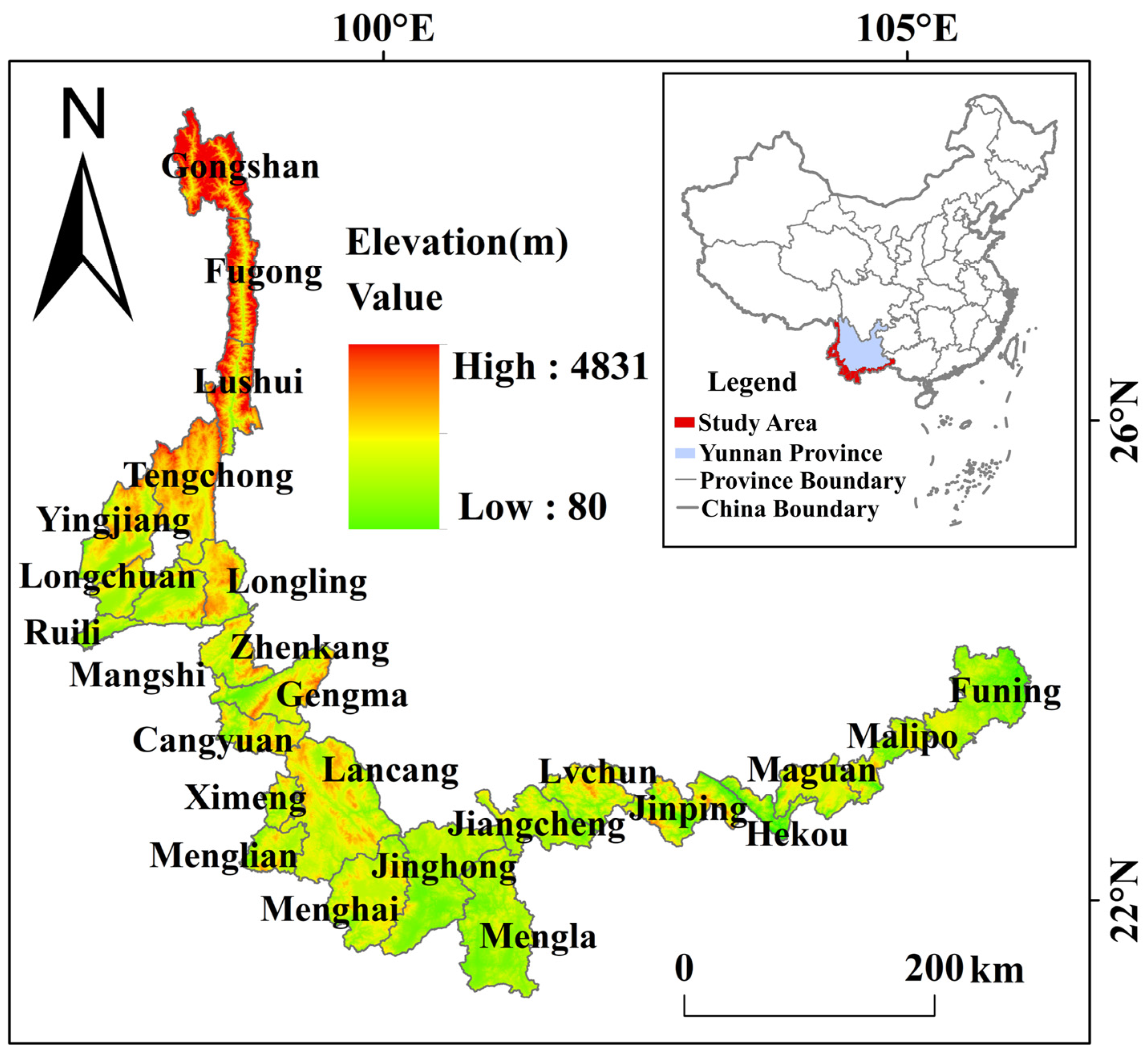
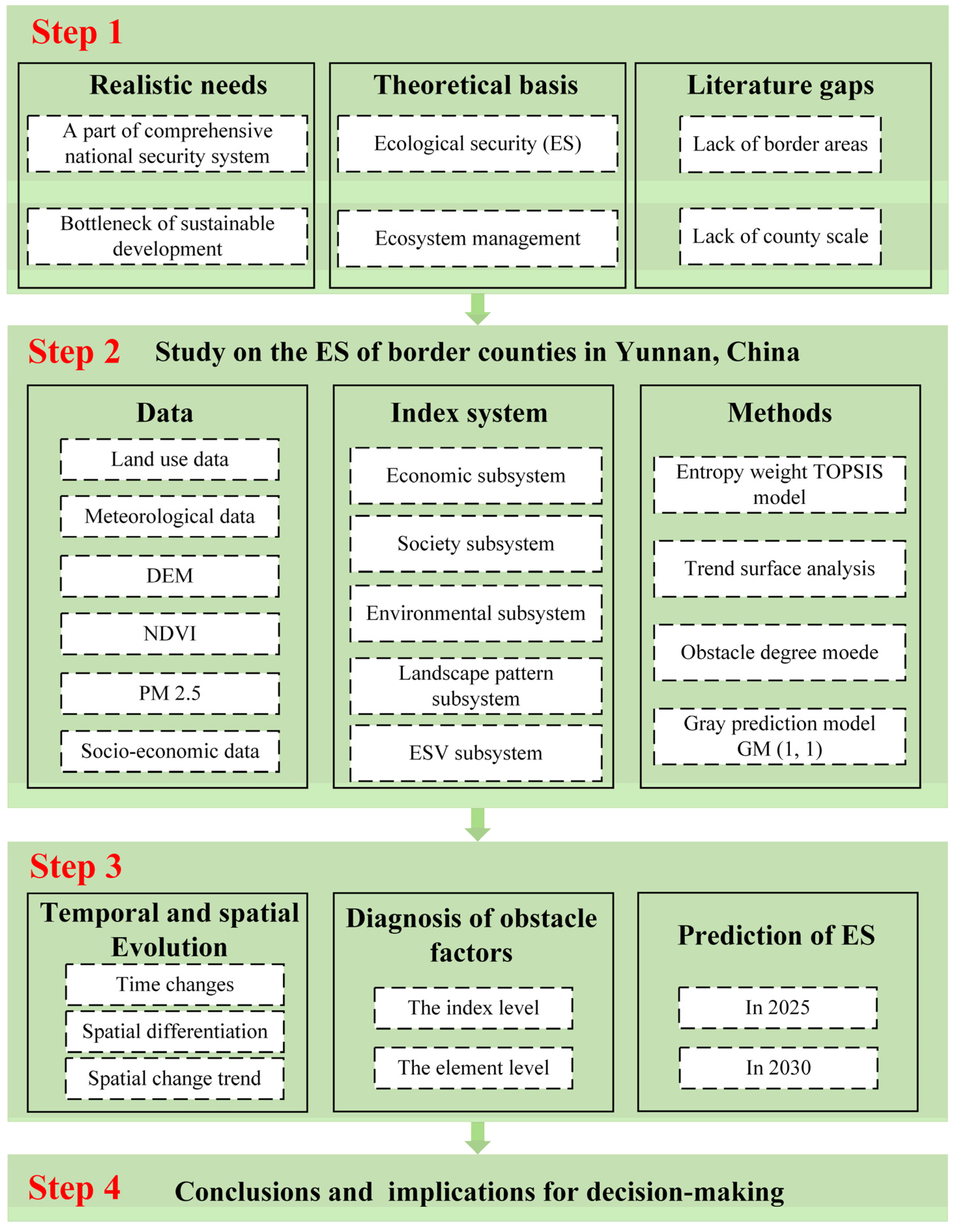


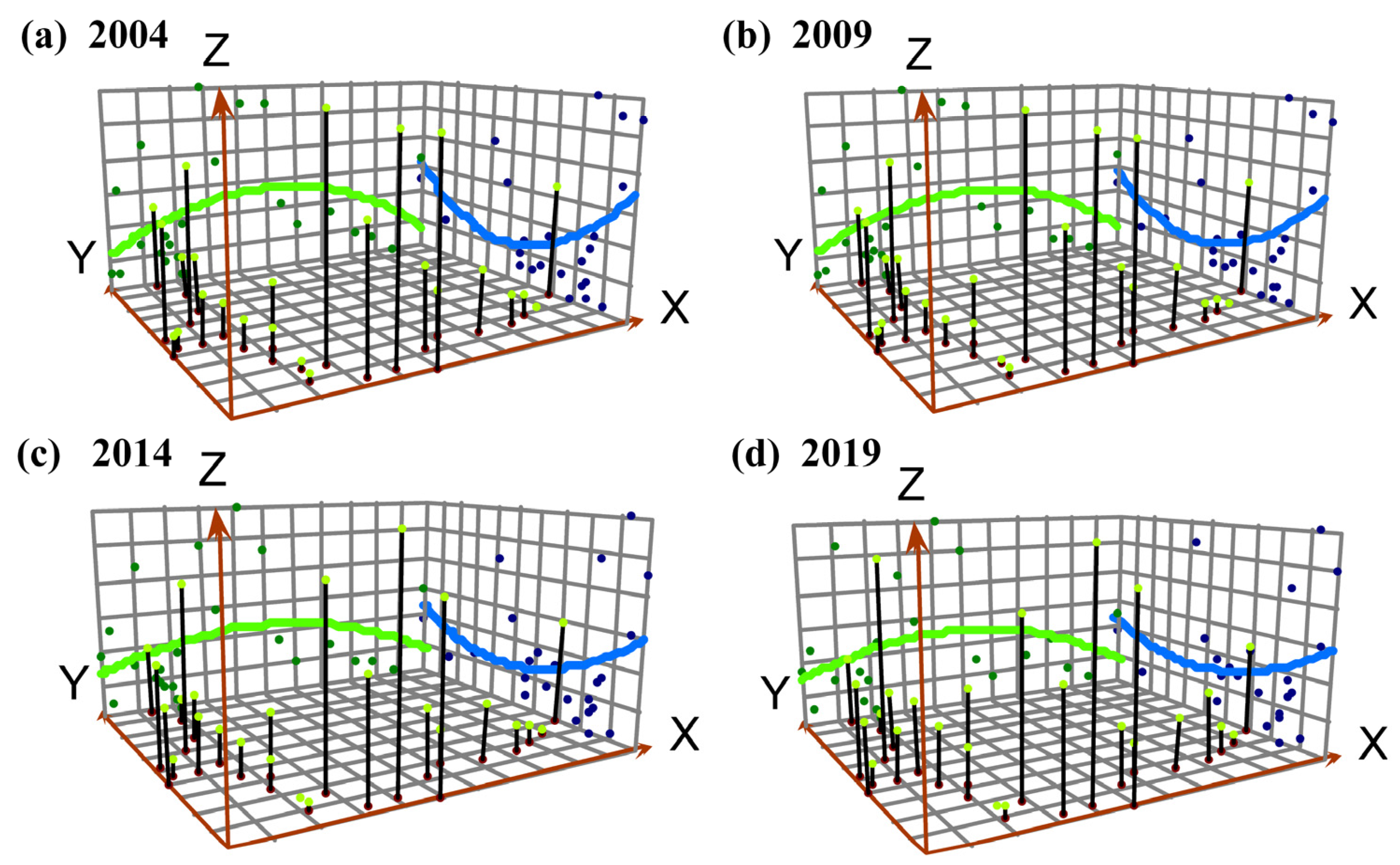


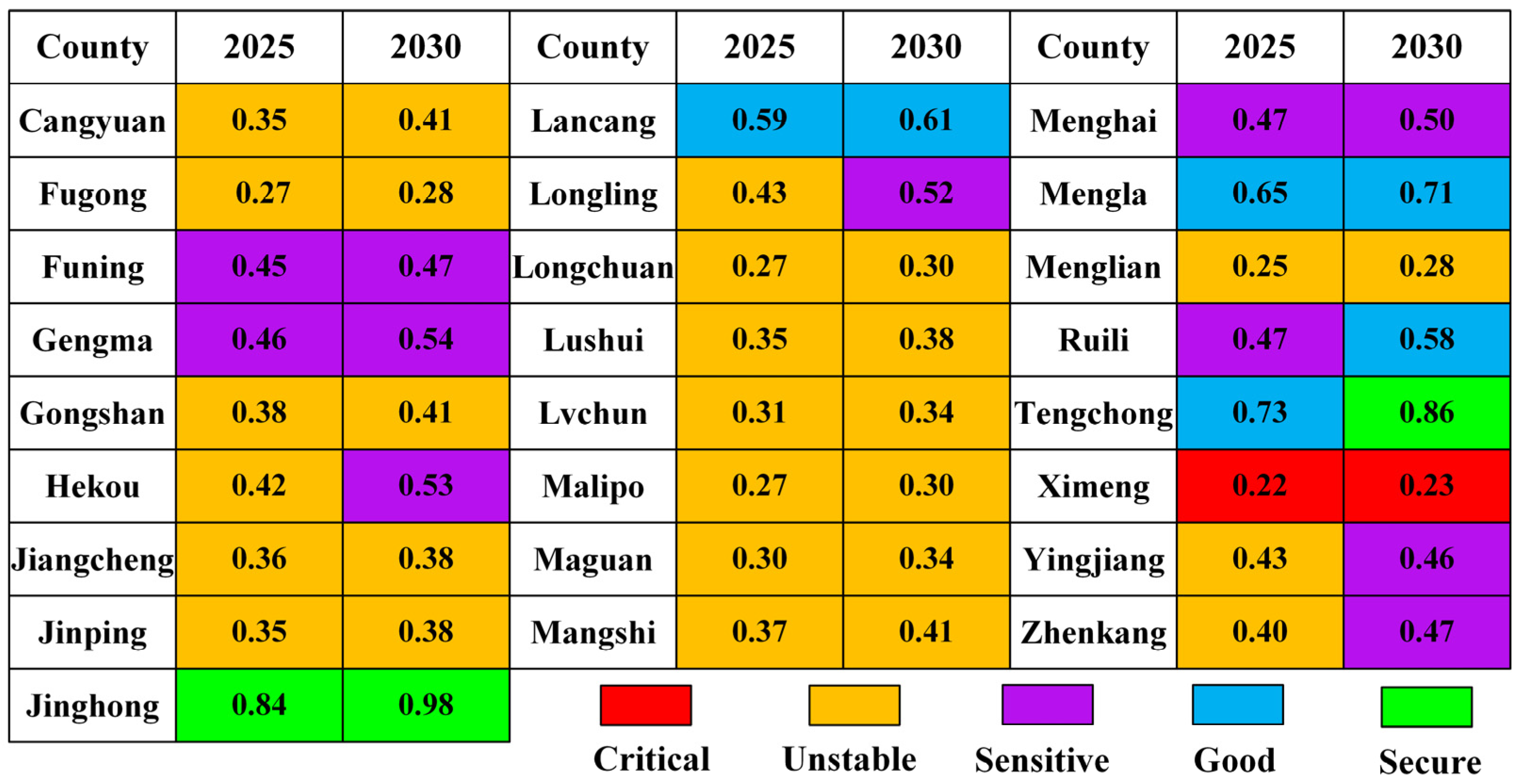
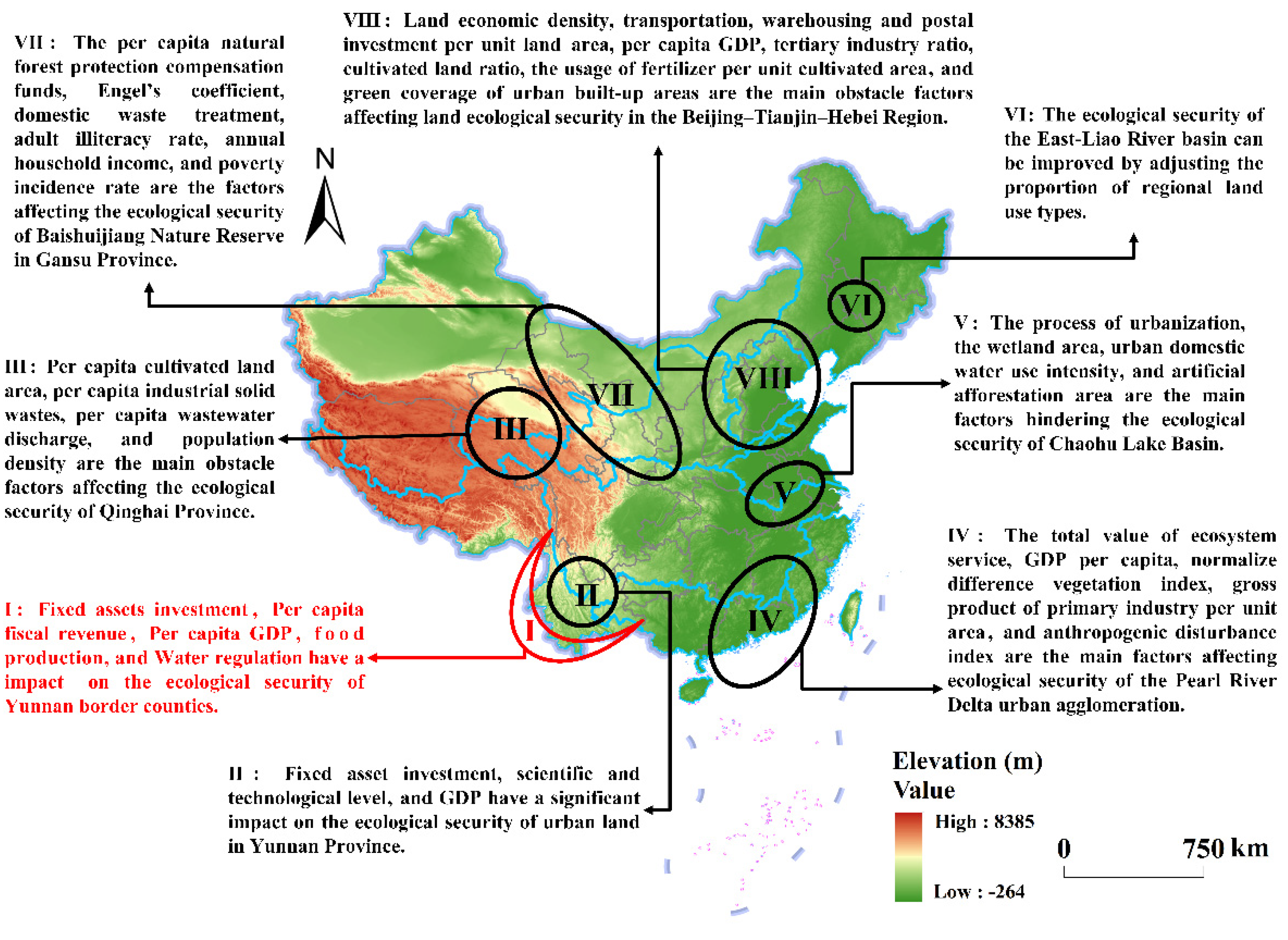
| Data Type | Time | Data Sources |
|---|---|---|
| Land use data | 2004–2019 | Land use type was classified into cropland, forest, shrub, grassland, water, snow and ice, barren, impervious, and wetland, with a spatial resolution of 30 m based on Yang and Huang [40]. The data were obtained from https://doi.org/10.5281/zenodo.4417810 (accessed on 4 June 2021). |
| Meteorological data | 2004–2019 | Derived from the National Science and Technology Infrastructure dataset (http://www.cma.gov.cn/, accessed on 17 July 2021). |
| Administrative boundary | 2015 | Obtained from the National Basic Geographic Information Center (http://www.ngcc.cn/, accessed on 6 January 2022); described basic geographic information at a scale of 1:4,000,000. |
| Digital Elevation Model (DEM) | / | A DEM with a spatial resolution 90 m was provided by the Resources and Environment Data Center of the Chinese Academy of Sciences (https://www.resdc.cn/, accessed on 4 January 2022). |
| Normalized Difference Vegetation Index (NDVI) | 2004–2019 | NDVI data were provided by the Resources and Environment Data Center of the Chinese Academy of Sciences (https://www.resdc.cn/, accessed on 14 July 2021). |
| Atmospheric Particulate Matter content with a diameter of <2.5 µm (PM 2.5) | 2004–2019 | Data were publicly available as vers. V4.GL.03 via the Atmospheric Composition Analysis Group website at Dalhousie University [41]. |
| Socio-economic data | 2004–2019 | Data obtained from the Yunnan Statistical Yearbook, county-level socioeconomic statistical yearbooks (China), Chinese agency government work reports, and social development statistical bulletins of each county. |
| Target Layer | Elements Layer | Index Layer | References |
|---|---|---|---|
| ES | Economic subsystem | X1: Annual GDP growth rate (%) | [52] |
| X2: Per-capita GDP (yuan) | [22] | ||
| X3: Secondary industry as percentage of GDP (%) | [53] | ||
| X4: Tertiary industry as percentage of GDP (%) | [25] | ||
| X5: Fixed assets investment (104 yuan) | [18] | ||
| X6: Per-capita fiscal revenue (yuan) | [25] | ||
| Society subsystem | X7: Population growth rate (%) | [24] | |
| X8: Population density (person/square kilometer) | [24,52] | ||
| X9: Per-capita food production (tons/person) | [22] | ||
| X10: Number of medical beds per 10,000 persons (pieces/ten thousand people) | [25] | ||
| X11: Urbanization level (%) | [43] | ||
| Environment subsystem | X12: Annual average temperature (°C) | [43] | |
| X13: Annual precipitation (mm) | [43] | ||
| X14: PM2.5 (μg/m3) | [24] | ||
| X15: NDVI (/) | [18] | ||
| X16: Forest cover (%) | [25] | ||
| X17: Proportion of construction land (%) | [26] | ||
| X18: Proportion of cultivated land (%) | [25] | ||
| Landscape pattern subsystem | X19: NP (/) | [54] | |
| X20: PD (/) | [12,43] | ||
| X21: LPI (/) | [43] | ||
| X22: ED (/) | [12] | ||
| X23: LSI (/) | [54,55] | ||
| X24: SPLIT (/) | [12,43] | ||
| X25: SHDI (/) | [12,43] | ||
| X26: AI (/) | [54,55] | ||
| ESV subsystem | X27: Food production (104 yuan) | [24,50] | |
| X28: Raw material (104 yuan) | [24,50] | ||
| X29: Water supply (104 yuan) | [24,50] | ||
| X30: Air quality regulation (104 yuan) | [24,50] | ||
| X31: Climate regulation (104 yuan) | [24,50] | ||
| X32: Waste treatment (104 yuan) | [24,50] | ||
| X33: Water regulation (104 yuan) | [24,50] | ||
| X34: Erosion prevention (104 yuan) | [24,50] | ||
| X35: Soil fertility maintenance (104 yuan) | [24,50] | ||
| X36: Habitat services (104 yuan) | [24,50] | ||
| X37: Cultural services (104 yuan) | [24,50] |
| Range | Status | Characteristics |
|---|---|---|
| [0, 0.25) | Critical | The pressure on the ecosystem is very large, the ecosystem structure is very imperfect, and the ecosystem has a very large risk of collapse. |
| [0.25, 0.45) | Unstable | The pressure on the ecosystem is large; the ecosystem structure has defects and is in an unstable state. |
| [0.45, 0.55) | Sensitive | The pressure on the ecosystem is large and close to the threshold; the ecosystem structure is relatively complete and can play the basic function of the ecosystem. |
| [0.55, 0.75) | Good | The ecosystem has relatively little pressure and perfect functions, and the ecosystem is in a relatively stable state. |
| [0.75, 1] | Secure | The pressure on the ecosystem is very small, the ecological function and structure are in excellent condition, and the ecosystem is in a very stable state. |
| County | Mape | County | Mape | County | Mape |
|---|---|---|---|---|---|
| Cangyuan | 3.47% | Lancang | 0.52% | Mengla | 2.26% |
| Fugong | 1.51% | Longling | 4.47% | Menglian | 1.91% |
| Funing | 0.80% | Longchuan | 1.41% | Ruili | 4.25% |
| Gengma | 3.28% | Lushui | 2.03% | Tengchong | 2.23% |
| Gongshan | 1.43% | Lvchun | 2.81% | Ximeng | 1.59% |
| Hekou | 5.93% | Malipo | 1.69% | Yingjiang | 0.80% |
| Jiangcheng | 0.74% | Maguan | 3.14% | Zhenkang | 2.98% |
| Jinping | 1.87% | Mangshi | 1.45% | ||
| Jinghong | 2.71% | Menghai | 1.46% |
Publisher’s Note: MDPI stays neutral with regard to jurisdictional claims in published maps and institutional affiliations. |
© 2022 by the authors. Licensee MDPI, Basel, Switzerland. This article is an open access article distributed under the terms and conditions of the Creative Commons Attribution (CC BY) license (https://creativecommons.org/licenses/by/4.0/).
Share and Cite
Hu, Z.; Qian, M.; Teng, X.; Zhang, Z.; Zhong, F.; Cheng, Q.; Wen, C. The Spatiotemporal Evolution of Ecological Security in Border Areas: A Case Study of Southwest China. Land 2022, 11, 892. https://doi.org/10.3390/land11060892
Hu Z, Qian M, Teng X, Zhang Z, Zhong F, Cheng Q, Wen C. The Spatiotemporal Evolution of Ecological Security in Border Areas: A Case Study of Southwest China. Land. 2022; 11(6):892. https://doi.org/10.3390/land11060892
Chicago/Turabian StyleHu, Zheneng, Meijun Qian, Xianghe Teng, Zhuoya Zhang, Fanglei Zhong, Qingping Cheng, and Chuanhao Wen. 2022. "The Spatiotemporal Evolution of Ecological Security in Border Areas: A Case Study of Southwest China" Land 11, no. 6: 892. https://doi.org/10.3390/land11060892






